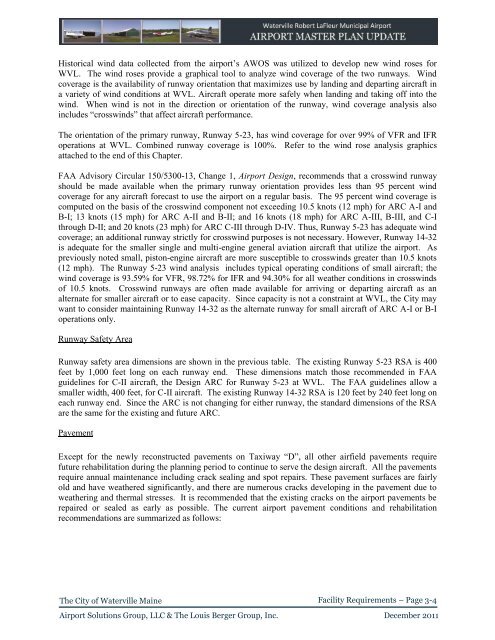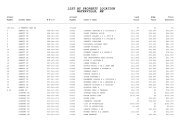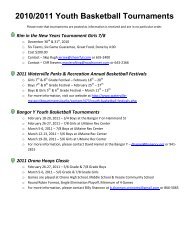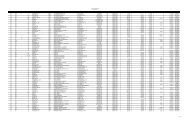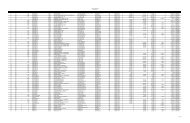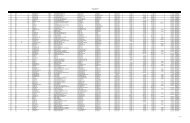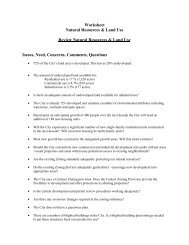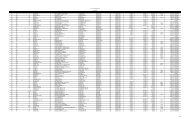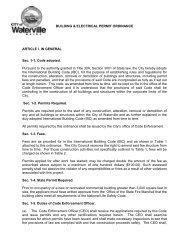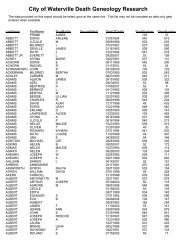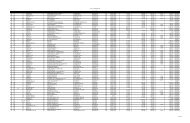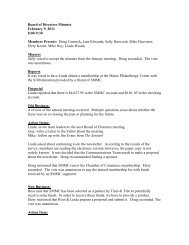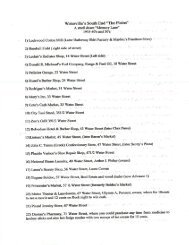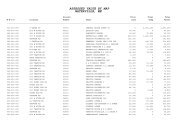Airport Master Plan 2012 - City of Waterville
Airport Master Plan 2012 - City of Waterville
Airport Master Plan 2012 - City of Waterville
You also want an ePaper? Increase the reach of your titles
YUMPU automatically turns print PDFs into web optimized ePapers that Google loves.
Historical wind data collected from the airport’s AWOS was utilized to develop new wind roses for<br />
WVL. The wind roses provide a graphical tool to analyze wind coverage <strong>of</strong> the two runways. Wind<br />
coverage is the availability <strong>of</strong> runway orientation that maximizes use by landing and departing aircraft in<br />
a variety <strong>of</strong> wind conditions at WVL. Aircraft operate more safely when landing and taking <strong>of</strong>f into the<br />
wind. When wind is not in the direction or orientation <strong>of</strong> the runway, wind coverage analysis also<br />
includes “crosswinds” that affect aircraft performance.<br />
The orientation <strong>of</strong> the primary runway, Runway 5-23, has wind coverage for over 99% <strong>of</strong> VFR and IFR<br />
operations at WVL. Combined runway coverage is 100%. Refer to the wind rose analysis graphics<br />
attached to the end <strong>of</strong> this Chapter.<br />
FAA Advisory Circular 150/5300-13, Change 1, <strong>Airport</strong> Design, recommends that a crosswind runway<br />
should be made available when the primary runway orientation provides less than 95 percent wind<br />
coverage for any aircraft forecast to use the airport on a regular basis. The 95 percent wind coverage is<br />
computed on the basis <strong>of</strong> the crosswind component not exceeding 10.5 knots (12 mph) for ARC A-I and<br />
B-I; 13 knots (15 mph) for ARC A-II and B-II; and 16 knots (18 mph) for ARC A-III, B-III, and C-I<br />
through D-II; and 20 knots (23 mph) for ARC C-III through D-IV. Thus, Runway 5-23 has adequate wind<br />
coverage; an additional runway strictly for crosswind purposes is not necessary. However, Runway 14-32<br />
is adequate for the smaller single and multi-engine general aviation aircraft that utilize the airport. As<br />
previously noted small, piston-engine aircraft are more susceptible to crosswinds greater than 10.5 knots<br />
(12 mph). The Runway 5-23 wind analysis includes typical operating conditions <strong>of</strong> small aircraft; the<br />
wind coverage is 93.59% for VFR, 98.72% for IFR and 94.30% for all weather conditions in crosswinds<br />
<strong>of</strong> 10.5 knots. Crosswind runways are <strong>of</strong>ten made available for arriving or departing aircraft as an<br />
alternate for smaller aircraft or to ease capacity. Since capacity is not a constraint at WVL, the <strong>City</strong> may<br />
want to consider maintaining Runway 14-32 as the alternate runway for small aircraft <strong>of</strong> ARC A-I or B-I<br />
operations only.<br />
Runway Safety Area<br />
Runway safety area dimensions are shown in the previous table. The existing Runway 5-23 RSA is 400<br />
feet by 1,000 feet long on each runway end. These dimensions match those recommended in FAA<br />
guidelines for C-II aircraft, the Design ARC for Runway 5-23 at WVL. The FAA guidelines allow a<br />
smaller width, 400 feet, for C-II aircraft. The existing Runway 14-32 RSA is 120 feet by 240 feet long on<br />
each runway end. Since the ARC is not changing for either runway, the standard dimensions <strong>of</strong> the RSA<br />
are the same for the existing and future ARC.<br />
Pavement<br />
Except for the newly reconstructed pavements on Taxiway “D”, all other airfield pavements require<br />
future rehabilitation during the planning period to continue to serve the design aircraft. All the pavements<br />
require annual maintenance including crack sealing and spot repairs. These pavement surfaces are fairly<br />
old and have weathered significantly, and there are numerous cracks developing in the pavement due to<br />
weathering and thermal stresses. It is recommended that the existing cracks on the airport pavements be<br />
repaired or sealed as early as possible. The current airport pavement conditions and rehabilitation<br />
recommendations are summarized as follows:<br />
The <strong>City</strong> <strong>of</strong> <strong>Waterville</strong> Maine<br />
Facility Requirements – Page 3-4<br />
<strong>Airport</strong> Solutions Group, LLC & The Louis Berger Group, Inc. December 2011


